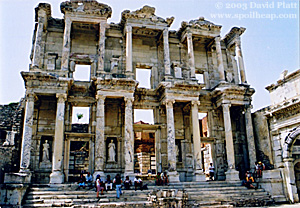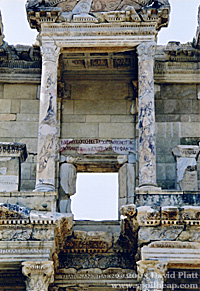
In May 2008, I submitted my PhD dissertation on the role that the donation of public libraries played in the definition of Roman civic spaces. The title was A Cultural Studies Approach to Roman Public Libraries: Social Negotiation, Changing Spaces, and Euergetism.
In this, I argue that Roman public libraries — although ostensibly dedicated to the cities and their communities — actually served to reproduce status differentiation rather than facilitate the spread of literacy … as a consequence of the literary technologies they contained, the ways in which the buildings shaped urban space, and the ways in which the buildings were funded.

Giving a public library accrued prestige and honour for the donor but it also established ties of obligation and reciprocity between the donor and community. Further, the decision to grant a city a public building rather than (for example) a feast or festival (which more people might enjoy more immediately) had a longer term benefit for a donor; it allowed him or her to define the character of the urban spaces in and around an area and the expectations of behaviour in those spaces. It granted the donor a kind of distributed agency (cf. Alfred Gell’s work on Art & Agency).
As today, buildings were expensive undertakings and this level of intervention in the cityscape was only within reach of people of means. However, in the case of the public libraries, I argue that the character of the technologies of literacy and relatively low literacy rates in the Roman Empire served to create even further status differentiation. The buildings created islands of elite space within the city.
The previous paragraphs make it sound all rather one-directional: the donor gave the gift, imposing his or her will on the cityscape. I actually go on to argue that the survival of these interventions in the cityscape was entirely at the consent of the community. Indeed, even getting the buildings put together in the first place required that the donor have the backing of key sections of the local population, as there were a number of legal avenues open to people who wanted to stop a building project. Over time, shifting cultural values could cause previously important public buildings to take on new functions or to be demolished entirely and their structural materials incorporated into new buildings. No matter how important and influential, the donor never had the last word on the fate of his gift. We can trace the shifting values and interests of ancient communities in the biographies of these and other buildings.
I am currently in the process of writing my first book proposal based on this research. My work is located in an ongoing discussion about how we analyze and understand the archaeology of urban spaces of the Graeco-Roman world. But in responding to recent work on ancient urban space, I take what’s useful for that discussion from a variety of writers in other fields such as anthropology, architecture, cultural/ human geography, urban studies, and the British school of cultural studies. As such, I hope that my arguments and the presentation of a detailed case study from a historical context will be of use to people working in other fields.
